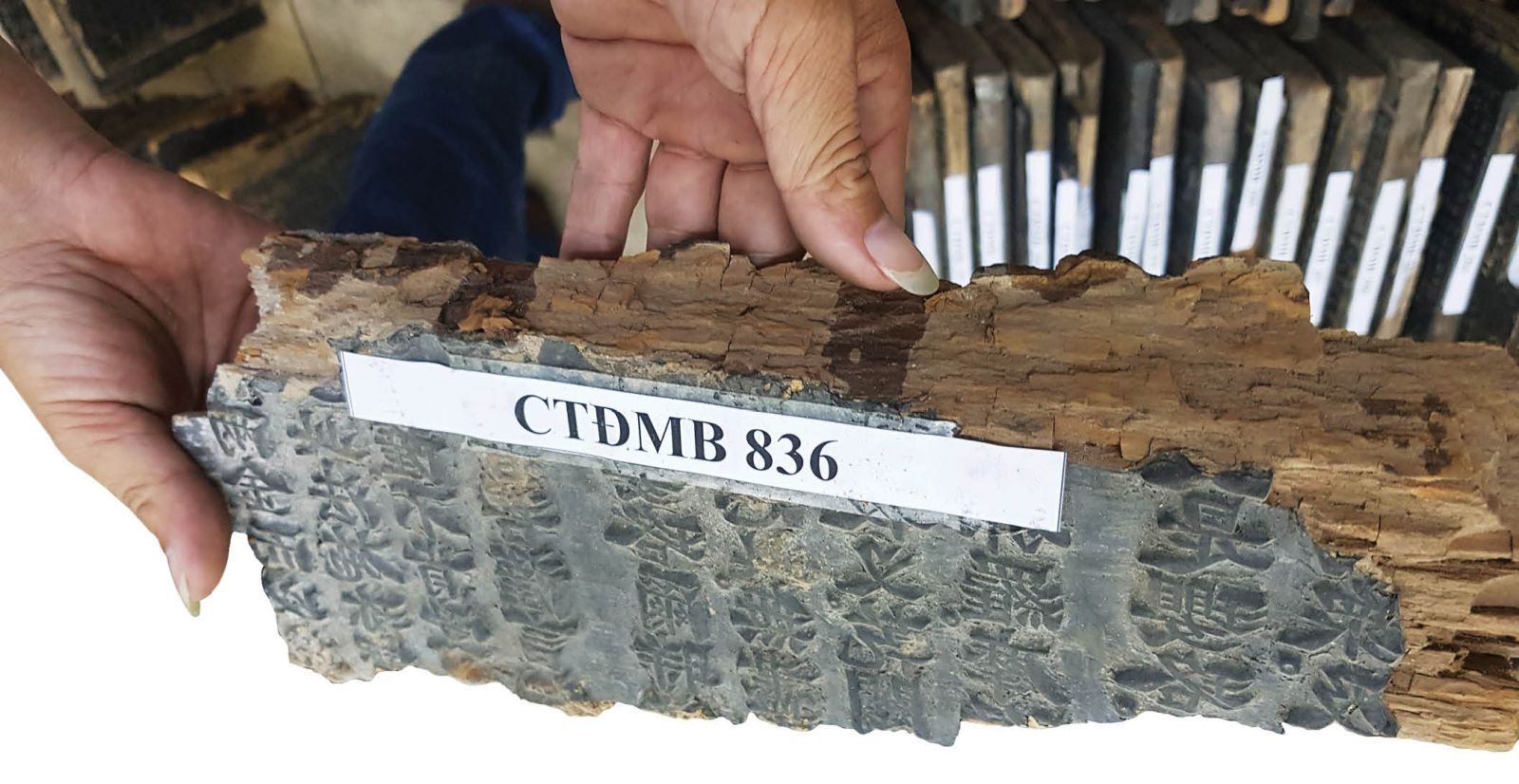Few people know that Hue owns such an invaluable asset. Part of the woodblocks found in pagodas and private homes has just been brought to Vietnam Buddhist Academy in Hue (An Tay Ward, Hue City) for protection and studies.

Woodblocks ruined by the time are being sorted and catalogued by researchers.
National treasure
The car carrying more than 800 woodblocks from Tu Dam Pagoda stopped in front of a room at the Buddhist Academy. People brought in the woodblocks with great care.
Among the places that the researchers surveyed, Tu Dam Pagoda owns the largest number of woodblocks. The woodblocks of diverse kinds and dates provide much valuable information.
The set of Diamond Sutra woodblocks is considered the oldest ever found in the Inner Realm. They were made in the 19th year of Chinh Hoa Dynasty (1698), i.e., during the reign of Lord Nguyen Phuc Chu.
Another sutra set, Tam Kiếp Tam Thiên Tôn Phật Danh Kinh (Business Pratyekabuddha Tam Kam Tam Buddha Sutra), was made in the 33rd year (1772) of Canh Hung Dynasty, and Phật Thánh Nhật Lịch (the Buddhist Calendar set), a year later. The letters are still clear and sharp after over hundreds of years. Besides, our ancestors were so talented to inscribe sophisticated images and patterns on them, too.
Venerable Thich Khong Nhien, Deputy Editor and Secretary of Lieu Quan Magazine at Lieu Quan Buddhist Cultural Center in Hue, who has for many years studied woodblocks, confirms that Buddhist woodblocks in Hue are not only a valuable documentary heritage for the Buddhist circle, but also an inextricably part of the national culture. They are related to the culture, history and linguistics of the Inner Realm and of Hue through historical periods.
Since many of them are damaged over time, the Buddhist circle, organizations and the authority in Hue need to find measures to support the storage, preservation and promotion of this valuable heritage. "This is the property of not only the Buddhist circle but also the nation,” stressed Thich Khong Nhien.
Concern about the loss of the heritage
At the Vietnam Buddhist Academy in Hue, more than 800 woodblocks were manually cleaned with brushes and water before sorting, cataloging, digitizing and copying. Many researchers who accessed these woodblocks were very surprised and claimed that it was huge heritage that we could take pride in.
Like the woodblocks of the Nguyen Dynasty, which are being stored in Da Lat in quite good conditions, Hue Buddhist woodblocks are gradually degraded by its own aging process and harsh climate. It is an alarming loss.
There is still a lot of controversy about how the woodblocks should be preserved. According to Mr. Nguyen Xuan Hung, Director of the National Archives IV, experts agree that the best conditions for woodblocks are: temperature is 18-21 degrees Celsius; humidity is at 60% ± 2%; light does not exceed 50 lux plus using air purifiers to filter pollutants.
However, appropriate facilities are not available in Hue at the moment. What we can do is keep them in an airy and dry place and avoid direct light.
“We are willing to support the Vietnam Buddhist Academy and pagodas in Hue in cleaning and preserving using modern methods. In the longer term, the heavily damaged woodblocks will be repaired and 3D digitized and the woodblocks will be displayed,” said Mr. Hung with sentiment.
Having the same idea, Le Tho Quoc from Sub-Institute of Culture and Arts in Hue City, a member of the researchers said that it was time for a specific project with scientific conservation methods at a common archive, otherwise we would lose our own heritage.
“In my opinion, in the immediate future, we need to request the support from the authorities in conserving the woodblocks at the storing places to avoid loss and damage. In the long run, it is necessary to build a museum displaying Hue Buddhist woodblocks,” said Mr. Quoc.
|
Introducing Buddhist woodblocks to the public
After many years of studying, the researcher team has accessed 13 places, discovering about 3,000 woodblocks of various ages and types including unique ancient graphic paintings. Tu Dam Pagoda owns the largest number with 1,319 woodblocks and the least number is at Tra Am Pagoda with only one.
Bringing the woodblocks to Vietnam Buddhist Academy in Hue is to facilitate the preservation of the priceless heritage and for experts, monks and nuns to study. In the future, a researching unit should be established to study more deeply and introduce the treasure to the public.
|
Story and photo: PHAN THANH